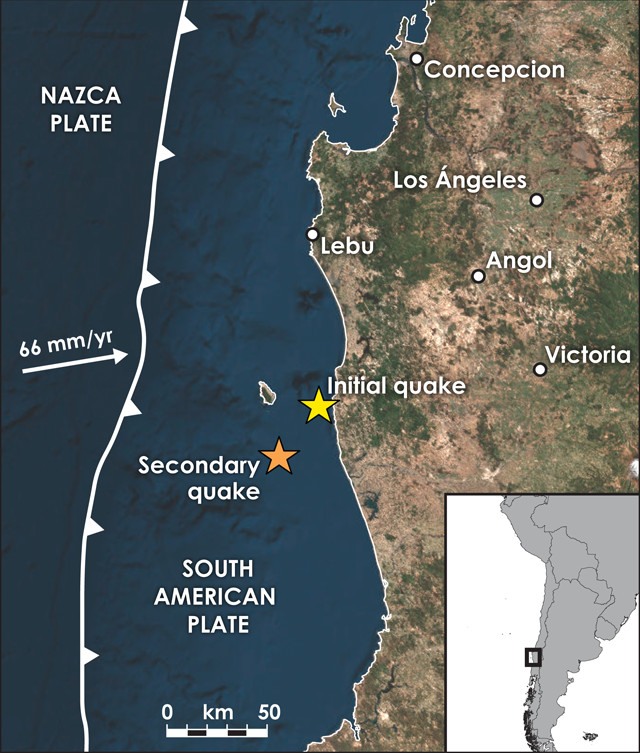
by Mary Caperton Morton Tuesday, February 9, 2016

Researchers found that a magnitude- 7.1 earthquake recorded on Jan. 2, 2011, was actually a closely spaced doublet of two similarly sized quakes. Credit: K. Cantner, AGI.
On Jan. 2, 2011, a magnitude-7.1 earthquake was recorded striking central Chile along the tectonic boundary between the Nazca and South American plates. Shaking from the quake was felt hundreds of kilometers from the epicenter, but no deaths or major damage were reported.
In a new study, researchers teasing apart the details of the event have found that what was once thought to be a single earthquake was actually two: an initial magnitude-6.8 quake followed by a magnitude-6.7 quake just 12 seconds later. The true nature of this double quake, called a closely spaced doublet, went undetected by local and global monitoring networks, demonstrating a potential challenge for earthquake and tsunami warning systems.
Doublets feature an aftershock of similar magnitude to the initial quake. The aftershock can occur on the same fault or a different fault and may take place within seconds or minutes of the mainshock, or even weeks or months later. Identifying closely spaced doublets presents a special challenge, however, because the seismic signature of the second event is often hidden within that of the first event.
“We don’t really know how common closely spaced doublets are because we’ve only developed the [seismic] resolution to identify them in the past few years,” says Stephen Hicks, a seismologist at the University of Liverpool in England and co-author of the new study, published in Nature Geoscience.
And even with this refined seismic resolution, further analysis must be done to bring the secondary event to the forefront of the seismic signature, says Thorne Lay, a seismologist at the University of California at Santa Cruz who was not involved in the new study. “This kind of event takes more detailed modeling and analysis than is typically performed by routine operations. In many cases, we may miss the second event because nobody is looking for it.”
Within the small library of doublets identified in the past decade, the Chilean event stands out due to the extremely close timing between the main quakes. “If you look at the event just using the U.S. Geological Survey [network] and other global monitoring networks, this event looks like a standard subduction zone earthquake,” Hicks says.
Through painstaking analysis of seismic data recorded during the 2011 event, Hicks and his colleagues identified the second earthquake, which occurred along a different fault 30 kilometers farther offshore from where the mainshock occurred. “When we modeled the [seismic] waves produced by the main event, we found that the second event was triggered when the largest S waves passed through that location,” Hicks says. Secondary waves, or S waves, are transverse seismic waves that are typically slower but more damaging than primary, or P, waves. “We think the second fault was probably already weak and close to failure and the high-amplitude S waves then caused it to fail.”
The doublet was even more unusual in that it occurred on two faults with different geometries: the first earthquake struck a compressional fault and the second an extensional fault. “This work challenges the commonly held notion that slip during large earthquakes may only occur along a single fault. The result was surprising as there was no indication of such a complicated rupture from global earthquake monitoring systems,” co-author Andreas Rietbrock, also of the University of Liverpool, said in a statement.
The Chilean doublet did not cause a tsunami, but in 2009, a magnitude-8 earthquake near Samoa set off a much larger tsunami than expected. Months later, a team led by Lay identified a doublet, also magnitude 8, that struck in much shallower water than the first, triggering a secondary tsunami wave. “These types of triggered secondary events are extremely unpredictable. The real-time rapid warning systems we have aren’t designed to disentangle complex events on the fly. As of now, these kinds of studies take months. It’s going to be a difficult problem to solve operationally,” Lay says.
The Pacific Tsunami Warning Center uses regional and global monitoring networks to make tsunami forecasts. “If this second event [in Chile] had triggered a tsunami, [these networks] may have missed it,” Hicks says. Although Chile is relatively well off overall in terms of the density of regional seismic networks, currently, he says, the country “doesn’t have a dense enough seismic network tied to the tsunami warning system.”
In the study, Hicks and his colleagues call for denser seismic networks along the Chilean coast to monitor for future doublets, as well as for expanding local and regional monitoring networks along other subduction zones, such as in Indonesia. Only Japan currently has a network sufficient to quickly identify closely spaced doublets and assess the associated tsunami risk, Hicks says.
“The seismic monitoring community needs to look at our monitoring systems and see what we can do to detect these secondary events, as well as to go back through seismic records to see whether this event in Chile was truly unique,” he says. “Or if it happens more often and is commonly missed by seismic networks.”
© 2008-2021. All rights reserved. Any copying, redistribution or retransmission of any of the contents of this service without the expressed written permission of the American Geosciences Institute is expressly prohibited. Click here for all copyright requests.